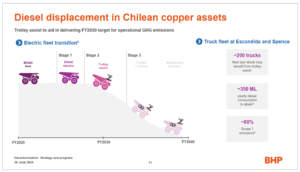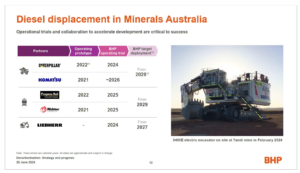BHP recently gave additional insight into its progress and plans related to emissions reduction in a special Decarbonisation Roundtable for investors held on June 26. Dr Graham Winkelman, BHP Vice President Climate said the global miner is on track to deliver its FY2030 target of at least a 30% reduction in operational GHG emissions in FY2030 against a FY2020 baseline adding that its medium-term target and long-term goal of net zero by 2050 are both related to Scopes 1 and 2 emissions from its operated assets, or ‘operational’ GHG emissions.
Winkelman continued: “As we grow to meet increasing demand for our commodities, the pathway to net zero for our operational emissions will not be a straight line. Our pathway reflects the dynamic nature of the assets we operate and the availability and readiness of decarbonisation solutions.”
Then it was over to Daniel Heal, Vice President Operational Decarbonisation, BHP Minerals Australia to talk about on the ground mining fleets. As might be expected, re: Scope 1 emissions, globally mining trucks represent BHP’s largest diesel usage. Each year, BHP’s global operations use roughly 1,850 megalitres of diesel in over 1,500 pieces of equipment – of which over half – 800+ are mining trucks.

Heal commented that BHP continues to believe that an electrified mining fleet will be more economic than hydrogen. “This is primarily driven by the overall efficiency of an electrified pathway, compared to other fuels…some of our core mining equipment is already available in an electrical configuration. For example, both BMA and Escondida operate electric shovels, and Escondida has had electric drills for many years. Electrification can also lead to improved maintenance performance, the elimination of diesel particulate matter, and reduction in noise and vibrations.”
He adds: “We consider alternative fuels such as biofuels as a backup option if electrification is delayed or unsuccessful, and we continue to monitor developments in this area. This is informed by a trial that concluded last year that provided us valuable insights into using hydro-treated vegetable oil in multiple types of mining equipment. The trial also identified some of the challenging commercial and social concerns associated with these fuels. Replacing diesel will require us to develop a whole new operational ecosystem to surround the fleet and every part of the mine will be touched by this change.”
Then Heal took its operations in Chile and Australia in turn. For its operated assets in Chile, BHP continues to study trolley assisted haul trucks at Escondida and Spence, to reduce diesel consumption but also as a key enabler for future rollout battery electric haul trucks. It will approach trolley assist in three stages. “Firstly, over the coming years we will be progressively replacing our current mechanical drive haul trucks with electric drive ones. Then, we will implement trolley assist. This electrical infrastructure works like an electric tram or train network. Trucks connect to it while moving and receive electricity directly to power their electric drives, reducing diesel use. We will soon begin testing diesel-electric trolley assist at Escondida, followed by Spence, with implementation of the first stage expected to start in FY2028 and FY2029, respectively.”

And finally, next decade, BHP will expand the trolley infrastructure to assist a transition from diesel-electric to battery electric haul trucks. This will allow the energy to go straight to charging the truck’s batteries while operating, reducing the time that the truck would need to stop to be charged. And once trolley and battery electric trucks are proven, it is planning a widespread adoption across its operated assets in Chile.
For diesel displacement in Australia, Heal said BHP is working through key areas including “the way we plan and operate our mines; how and when we charge our equipment; how we manage power supply and demand; the skills and people we will need; and, critically, the additional safety considerations these changes will bring.”
BHP is collaborating with equipment manufacturers and others across the industry to accelerate development of the technology required. It has a comprehensive program of trials underway or set to start in the coming years. He added that some of these dates have shifted a little since it presented a similar table last year, but added that this is not surprising given the complexity of developing new technology at this scale. “Despite this, we still anticipate our first battery-electric truck sites and locomotives to be in operation from late this decade – assuming our trials are successful.”
BHP currently has the first Caterpillar battery electric haul truck enroute to its WAIO Jimblebar mine, and in June Heal and the decarbonisation team from BHP visited Caterpillar’s Proving Ground in Tucson Arizona to witness the very first Caterpillar 793 battery electric truck in action. He states: “In terms of performance, we are expecting it to be on par or even superior to an equivalent diesel truck. Fully loaded to its rated capacity, the Caterpillar battery electric truck achieved the same top speed as a diesel equivalent truck and travelled 1 kilometre up a 10% grade at the same pace as a diesel truck. A battery electric truck will need to be charged more often than a diesel truck is currently refuelled, but we expect to be able to counter that in some places using dynamic energy transfer, such as trolley systems.”
Furthermore, when receiving electricity directly through a dynamic energy transfer system, BHP expects a battery truck could outperform a current diesel truck uphill and, on a downhill grade, the truck captures the energy that would normally be lost to heat and returns it to the battery. “Our planned site trials will gather real data to help firm up modelling assumptions, inform the investment business cases and provide greater certainty to our plans.”
The presentation stated that BHP expects operational deployment of both the Caterpillar Early Learner battery truck and Komatsu’s battery truck (the Power Agnostic battery truck) from 2028 (the Komatsu trucks are set to be delivered to the Pilbara in 2026), should successful trials be completed – to speed up learnings BHP is trialling the Caterpillar BEV truck and Rio Tinto the Komatsu BEV truck.
Another example of trial progress is BHP’s deployment of a Liebherr 9400E electric excavator, which is one of the first in Australia, which has been operating in a trial since early 2024 at its Yandi operations, part of West Australia Iron Ore. It says these electric excavators are set for deployment from 2027.











